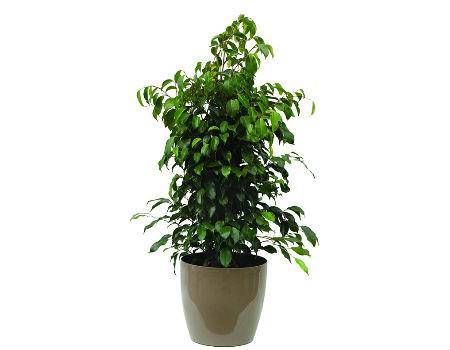Latin name: Ficus benjamina
Family: Moraceae
A large family of houseplants, home to many species. Ficus Benjamin has dark green leaves that droop downwards, and are a very beautiful decorative choice both inside the house and near artificial ponds. The young leaves are light green in colour, and darken as they mature. As easy as it is for the plant to put out young leaves, it can easily shed them once the lighting conditions are not right.
Did you know that you can create your own Benjamin plant?By cutting off extreme hard cuttings about 10 cm long, and placing them in wet peat. The ambient temperature should be around 21 degrees Celsius.
Light – Position – Temperature
Ficus Benjamin is a plant that needs a lot of light, but not direct sun. A sign that the plant is not in the right position is the rapid yellowing and consequently the falling of the leaves. In such a case, you should move the plant to a brighter position in the room. The growth temperature of the plant is from 18 to 21 degrees Celsius, while the maximum temperature of resistance is 23 degrees. Like most houseplants, they do not thrive near drafty windows.
Watering – Fertilization
Another cause of yellowing leaves is overwatering. The frequency of watering should be 1 to 2 times a week in the summer months and once every 7 or even 10 days in the winter months. Fertilization is done with liquid fertilizer during the growing season, and daily sprinkling will also help its growth. Every spring it is a good idea to change pots if necessary, but the soil should definitely be renewed. Pruning is done in spring, avoiding cutting young shoots.
Enemies – Diseases
The ficus can be attacked by coccoids. Both young and black hardy insects settle on both the leaves and the trunk and can do the same damage to our plant. Benjamin is particularly susceptible to coccoids, so it needs frequent checking under the leaves of the plant. If you notice a few insects, they are dealt with by wiping the leaves with a cotton ball dipped in malathion, and if you notice a lot of insects, you should soak the plant in malathion.Using the same technique, we can get rid of the false bollworm, which sometimes attacks Benjamin.The most common enemy of all plants is overwatering. Very quickly the roots will rot, as the soil becomes soggy and oxygen does not reach the roots. The only solution in this case is to let the soil dry out thoroughly and wait for the plant to grow new roots.

